Pg 9 GENESIS GV80 2021 Owner's Manual
[x] Cancel search | Manufacturer: GENESIS, Model Year: 2021, Model line: GV80, Model: GENESIS GV80 2021Pages: 632, PDF Size: 9.37 MB
Page 581 of 632
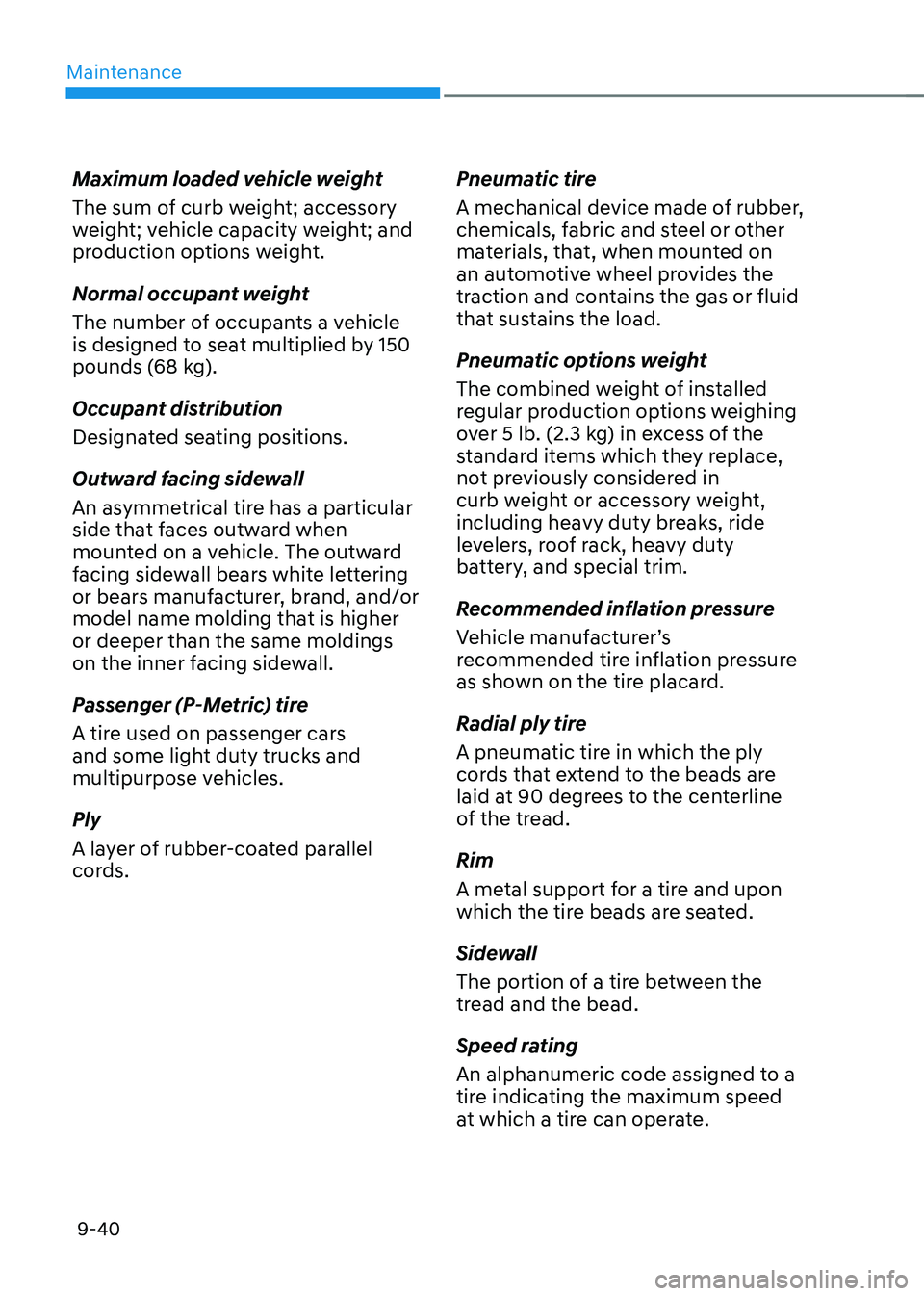
Maintenance
9-40
Maximum loaded vehicle weight
The sum of curb weight; accessory
weight; vehicle capacity weight; and
production options weight.
Normal occupant weight
The number of occupants a vehicle
is designed to seat multiplied by 150
pounds (68 kg).
Occupant distribution
Designated seating positions.
Outward facing sidewall
An asymmetrical tire has a particular
side that faces outward when
mounted on a vehicle. The outward
facing sidewall bears white lettering
or bears manufacturer, brand, and/or
model name molding that is higher
or deeper than the same moldings
on the inner facing sidewall.
Passenger (P-Metric) tire
A tire used on passenger cars
and some light duty trucks and
multipurpose vehicles.
Ply
A layer of rubber-coated parallel
cords.Pneumatic tire
A mechanical device made of rubber,
chemicals, fabric and steel or other
materials, that, when mounted on
an automotive wheel provides the
traction and contains the gas or fluid
that sustains the load.
Pneumatic options weight
The combined weight of installed
regular production options weighing
over 5 lb. (2.3 kg) in excess of the
standard items which they replace,
not previously considered in
curb weight or accessory weight,
including heavy duty breaks, ride
levelers, roof rack, heavy duty
battery, and special trim.
Recommended inflation pressure
Vehicle manufacturer’s
recommended tire inflation pressure
as shown on the tire placard.
Radial ply tire
A pneumatic tire in which the ply
cords that extend to the beads are
laid at 90 degrees to the centerline
of the tread.
Rim
A metal support for a tire and upon
which the tire beads are seated.
Sidewall
The portion of a tire between the
tread and the bead.
Speed rating
An alphanumeric code assigned to a
tire indicating the maximum speed
at which a tire can operate.
Page 582 of 632
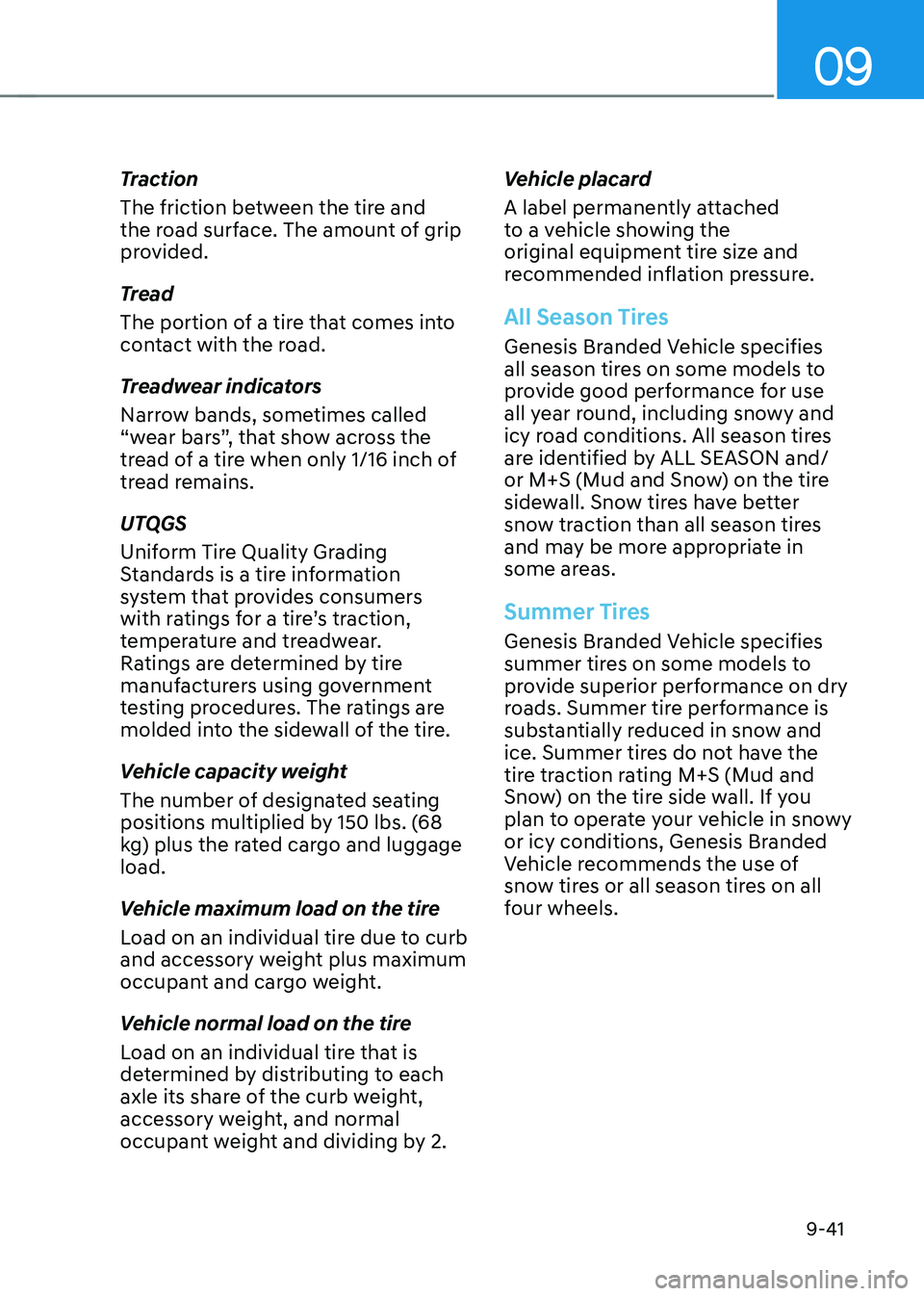
09
9-41
Traction
The friction between the tire and
the road surface. The amount of grip
provided.
Tread
The portion of a tire that comes into
contact with the road.
Treadwear indicators
Narrow bands, sometimes called
“wear bars”, that show across the
tread of a tire when only 1/16 inch of
tread remains.
UTQGS
Uniform Tire Quality Grading
Standards is a tire information
system that provides consumers
with ratings for a tire’s traction,
temperature and treadwear.
Ratings are determined by tire
manufacturers using government
testing procedures. The ratings are
molded into the sidewall of the tire.
Vehicle capacity weight
The number of designated seating
positions multiplied by 150 lbs. (68
kg) plus the rated cargo and luggage
load.
Vehicle maximum load on the tire
Load on an individual tire due to curb
and accessory weight plus maximum
occupant and cargo weight.
Vehicle normal load on the tire
Load on an individual tire that is
determined by distributing to each
axle its share of the curb weight,
accessory weight, and normal
occupant weight and dividing by 2.Vehicle placard
A label permanently attached
to a vehicle showing the
original equipment tire size and
recommended inflation pressure.
All Season Tires
Genesis Branded Vehicle specifies
all season tires on some models to
provide good performance for use
all year round, including snowy and
icy road conditions. All season tires
are identified by ALL SEASON and/
or M+S (Mud and Snow) on the tire
sidewall. Snow tires have better
snow traction than all season tires
and may be more appropriate in
some areas.
Summer Tires
Genesis Branded Vehicle specifies
summer tires on some models to
provide superior performance on dry
roads. Summer tire performance is
substantially reduced in snow and
ice. Summer tires do not have the
tire traction rating M+S (Mud and
Snow) on the tire side wall. If you
plan to operate your vehicle in snowy
or icy conditions, Genesis Branded
Vehicle recommends the use of
snow tires or all season tires on all
four wheels.
Page 583 of 632
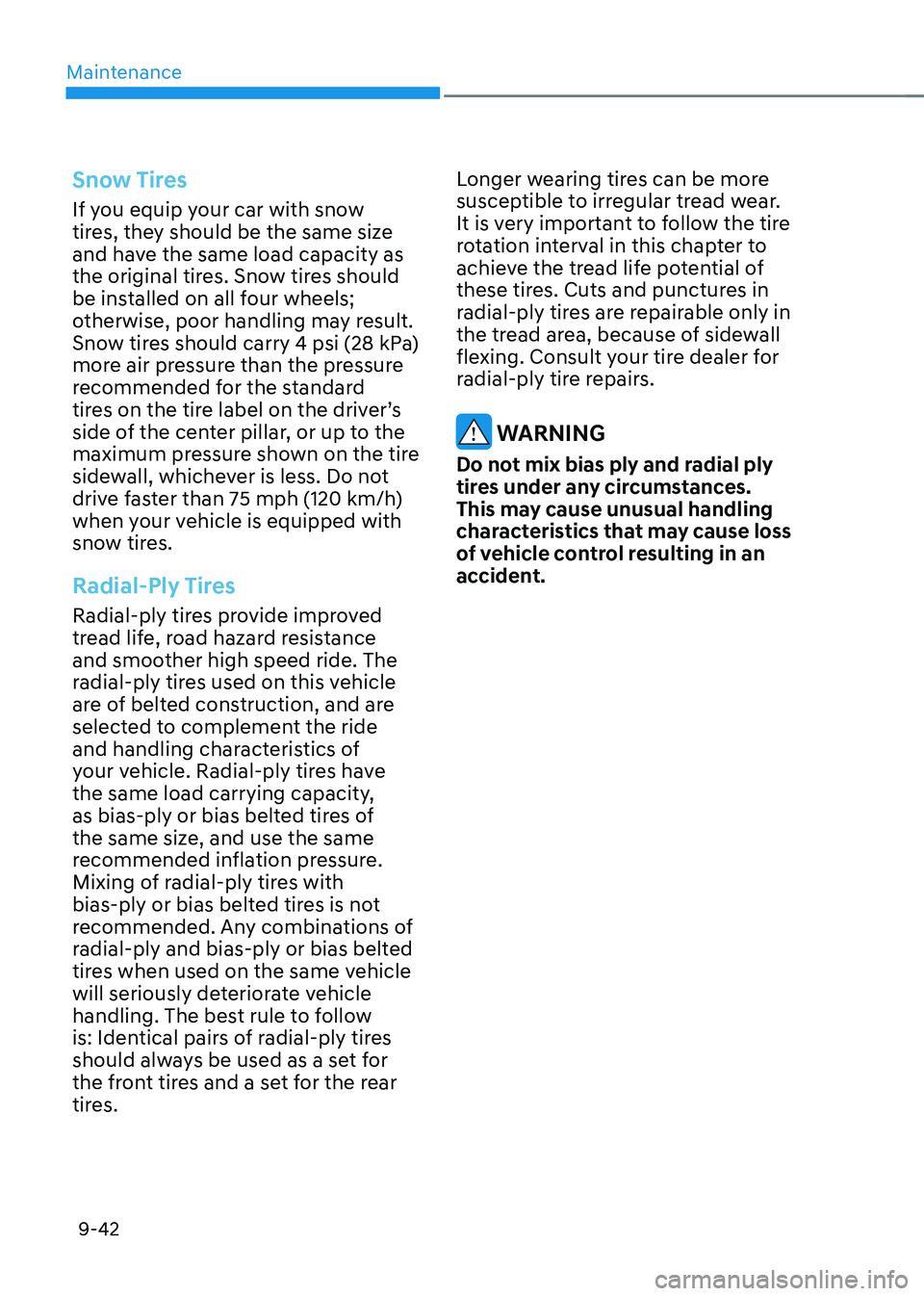
Maintenance
9-42
Snow Tires
If you equip your car with snow
tires, they should be the same size
and have the same load capacity as
the original tires. Snow tires should
be installed on all four wheels;
otherwise, poor handling may result.
Snow tires should carry 4 psi (28 kPa)
more air pressure than the pressure
recommended for the standard
tires on the tire label on the driver’s
side of the center pillar, or up to the
maximum pressure shown on the tire
sidewall, whichever is less. Do not
drive faster than 75 mph (120 km/h)
when your vehicle is equipped with
snow tires.
Radial-Ply Tires
Radial-ply tires provide improved
tread life, road hazard resistance
and smoother high speed ride. The
radial-ply tires used on this vehicle
are of belted construction, and are
selected to complement the ride
and handling characteristics of
your vehicle. Radial-ply tires have
the same load carrying capacity,
as bias-ply or bias belted tires of
the same size, and use the same
recommended inflation pressure.
Mixing of radial-ply tires with
bias-ply or bias belted tires is not
recommended. Any combinations of
radial-ply and bias-ply or bias belted
tires when used on the same vehicle
will seriously deteriorate vehicle
handling. The best rule to follow
is: Identical pairs of radial-ply tires
should always be used as a set for
the front tires and a set for the rear
tires.Longer wearing tires can be more
susceptible to irregular tread wear.
It is very important to follow the tire
rotation interval in this chapter to
achieve the tread life potential of
these tires. Cuts and punctures in
radial-ply tires are repairable only in
the tread area, because of sidewall
flexing. Consult your tire dealer for
radial-ply tire repairs.
WARNING
Do not mix bias ply and radial ply
tires under any circumstances.
This may cause unusual handling
characteristics that may cause loss
of vehicle control resulting in an
accident.
Page 584 of 632

09
9-43
Low Aspect Ratio Tires
(if equipped)
The aspect ratio is lower than 50 on
low aspect ratio tires.
Because low aspect ratio tires are
optimized for handling and braking,
their sidewall is a little stiffer than
a standard tire. Also low aspect
ratio tires tend to be wider and
consequently have a greater contact
patch with the road surface. In some
instances they may generate more
road noise compared with standard
tires.
CAUTION
The side wall of a low aspect ratio
tire is shorter than the normal one.
Thus, the low-aspect wheel and
tire are easily damaged. Follow the
below instructions.
• When driving on a rough road or
driving off a road, be careful not
to damage the tires and wheels.
After driving, inspect the tires
and wheels.
• When passing over a pothole,
speed bump, manhole, or curb
stone, drive the vehicle slowly so
as not to damage the tires and
wheels.
• When there is an impact on a tire,
inspect the tire condition. Or,
contact an authorized retailer of
Genesis Branded products.
• Inspect the tire condition and
pressure every 1,800 miles
(3,000 km) to prevent tire
damage.
• It is difficult to recognize a tire
damage only with your eyes.
When there is a slight hint of a
tire damage, check and replace
the tire to prevent the damage
caused by air leakage.
• When a tire is damaged while
driving on a rough road, off a
road, or over obstacles, such as a
pothole, manhole, or curb stone,
your warranty does not cover the
damage.
• The tire information is specified
on the tire side wall.
Page 585 of 632
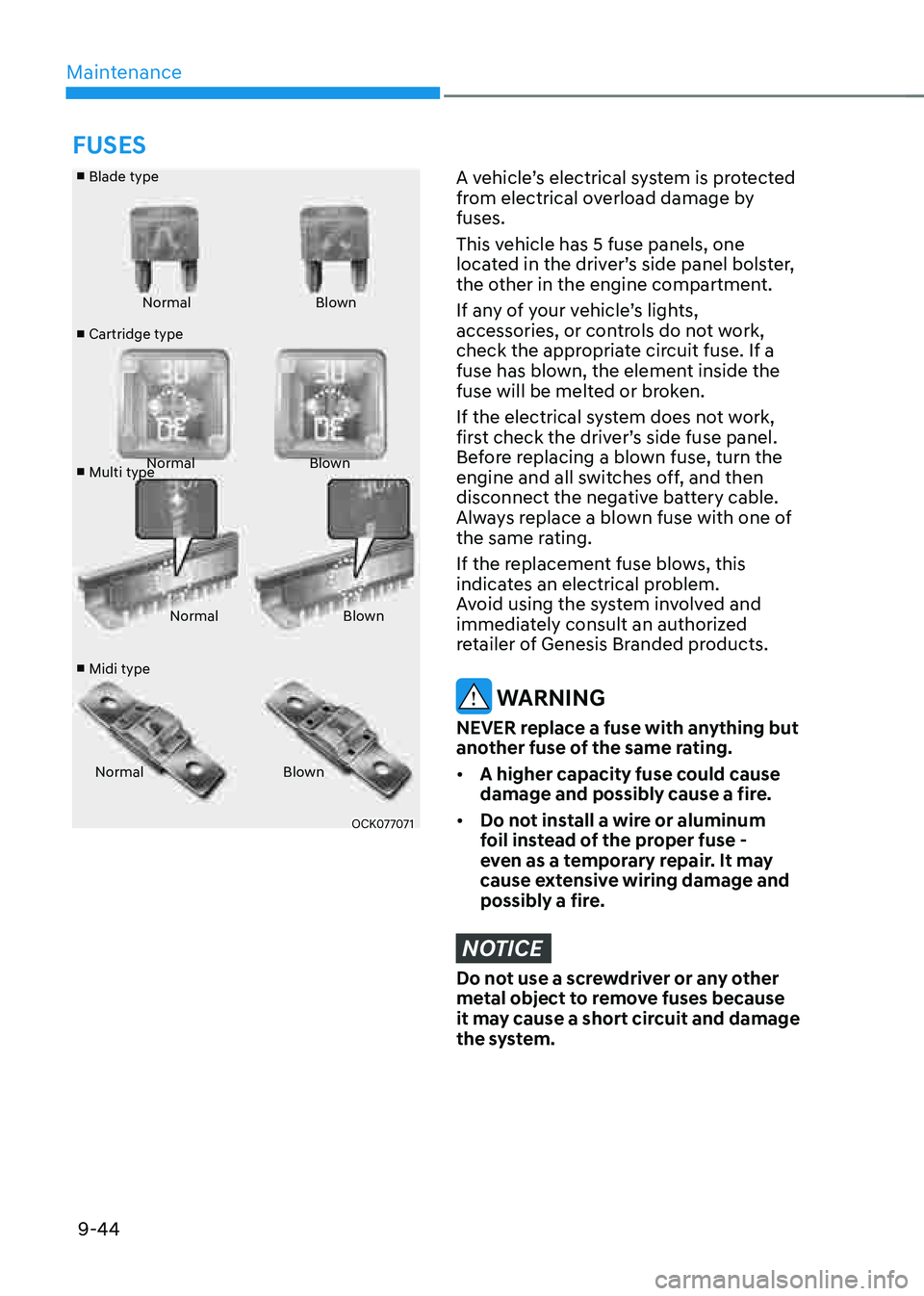
Maintenance
9-44
■ Blade type
■ Cartridge type
■ Multi type
■ Midi type Normal
Blown
Normal Blown
Normal Blown
Normal Blown
OCK077071OCK077071
A vehicle’s electrical system is protected
from electrical overload damage by
fuses.
This vehicle has 5 fuse panels, one
located in the driver’s side panel bolster,
the other in the engine compartment.
If any of your vehicle’s lights,
accessories, or controls do not work,
check the appropriate circuit fuse. If a
fuse has blown, the element inside the
fuse will be melted or broken.
If the electrical system does not work,
first check the driver’s side fuse panel.
Before replacing a blown fuse, turn the
engine and all switches off, and then
disconnect the negative battery cable.
Always replace a blown fuse with one of
the same rating.
If the replacement fuse blows, this
indicates an electrical problem.
Avoid using the system involved and
immediately consult an authorized
retailer of Genesis Branded products.
WARNING
NEVER replace a fuse with anything but
another fuse of the same rating.
• A higher capacity fuse could cause
damage and possibly cause a fire.
• Do not install a wire or aluminum
foil instead of the proper fuse -
even as a temporary repair. It may
cause extensive wiring damage and
possibly a fire.
NOTICE
Do not use a screwdriver or any other
metal object to remove fuses because
it may cause a short circuit and damage
the system.
FUSES
Page 586 of 632

09
9-45
Instrument Panel Fuse
Replacement
�
Page 587 of 632

Maintenance
9-46
Engine Compartment Panel Fuse
Replacement
Blade fuse / Cartridge fuse
�
Page 588 of 632

09
9-47
Fuse/Relay Panel Description
Instrument panel fuse panel
OJX1090023NOJX1090023N
Inside the fuse/relay box cover, you can
find the fuse/relay label describing fuse/
relay names and ratings.
Information
Not all fuse panel descriptions in this
manual may be applicable to your vehicle;
the information is accurate at the time of
printing. When you inspect the fuse box on
your vehicle, refer to the fuse box label.
OJX1090047N
Page 589 of 632
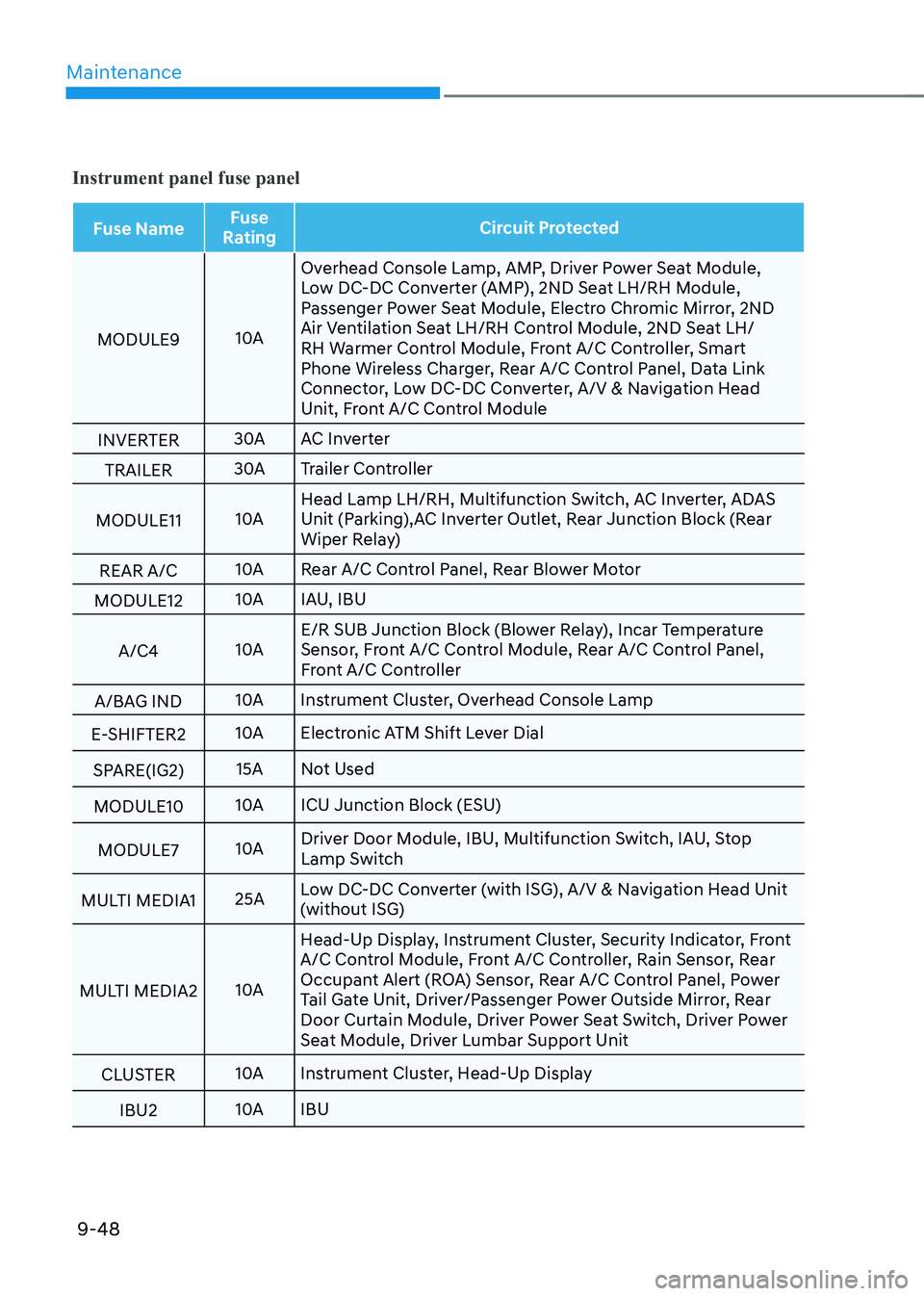
Maintenance
9-48
Instrument panel fuse panel
Fuse NameFuse
Rating Circuit Protected
MODULE9 10AOverhead Console Lamp, AMP, Driver Power Seat Module,
Low DC-DC Converter (AMP), 2ND Seat LH/RH Module,
Passenger Power Seat Module, Electro Chromic Mirror, 2ND
Air Ventilation Seat LH/RH Control Module, 2ND Seat LH/
RH Warmer Control Module, Front A/C Controller, Smart
Phone Wireless Charger, Rear A/C Control Panel, Data Link
Connector, Low DC-DC Converter, A/V & Navigation Head
Unit, Front A/C Control Module
INVERTER 30A
AC Inverter
TRAILER 30A
Trailer Controller
MODULE11 10AHead Lamp LH/RH, Multifunction Switch, AC Inverter, ADAS
Unit (Parking),AC Inverter Outlet, Rear Junction Block (Rear
Wiper Relay)
REAR A/C 10A
Rear A/C Control Panel, Rear Blower Motor
MODULE12 10A
IAU, IBU
A/C4 10AE/R SUB Junction Block (Blower Relay), Incar Temperature
Sensor, Front A/C Control Module, Rear A/C Control Panel,
Front A/C Controller
A/BAG IND 10A
Instrument Cluster, Overhead Console Lamp
E-SHIFTER2 10A
Electronic ATM Shift Lever Dial
SPARE(IG2) 15A
Not Used
MODULE10 10A
ICU Junction Block (ESU)
MODULE7 10ADriver Door Module, IBU, Multifunction Switch, IAU, Stop
Lamp Switch
MULTI MEDIA1 25ALow DC-DC Converter (with ISG), A/V & Navigation Head Unit
(without ISG)
MULTI MEDIA2 10AHead-Up Display, Instrument Cluster, Security Indicator, Front
A/C Control Module, Front A/C Controller, Rain Sensor, Rear
Occupant Alert (ROA) Sensor, Rear A/C Control Panel, Power
Tail Gate Unit, Driver/Passenger Power Outside Mirror, Rear
Door Curtain Module, Driver Power Seat Switch, Driver Power
Seat Module, Driver Lumbar Support Unit
CLUSTER 10A
Instrument Cluster, Head-Up Display
IBU2 10A
IBU
Page 590 of 632
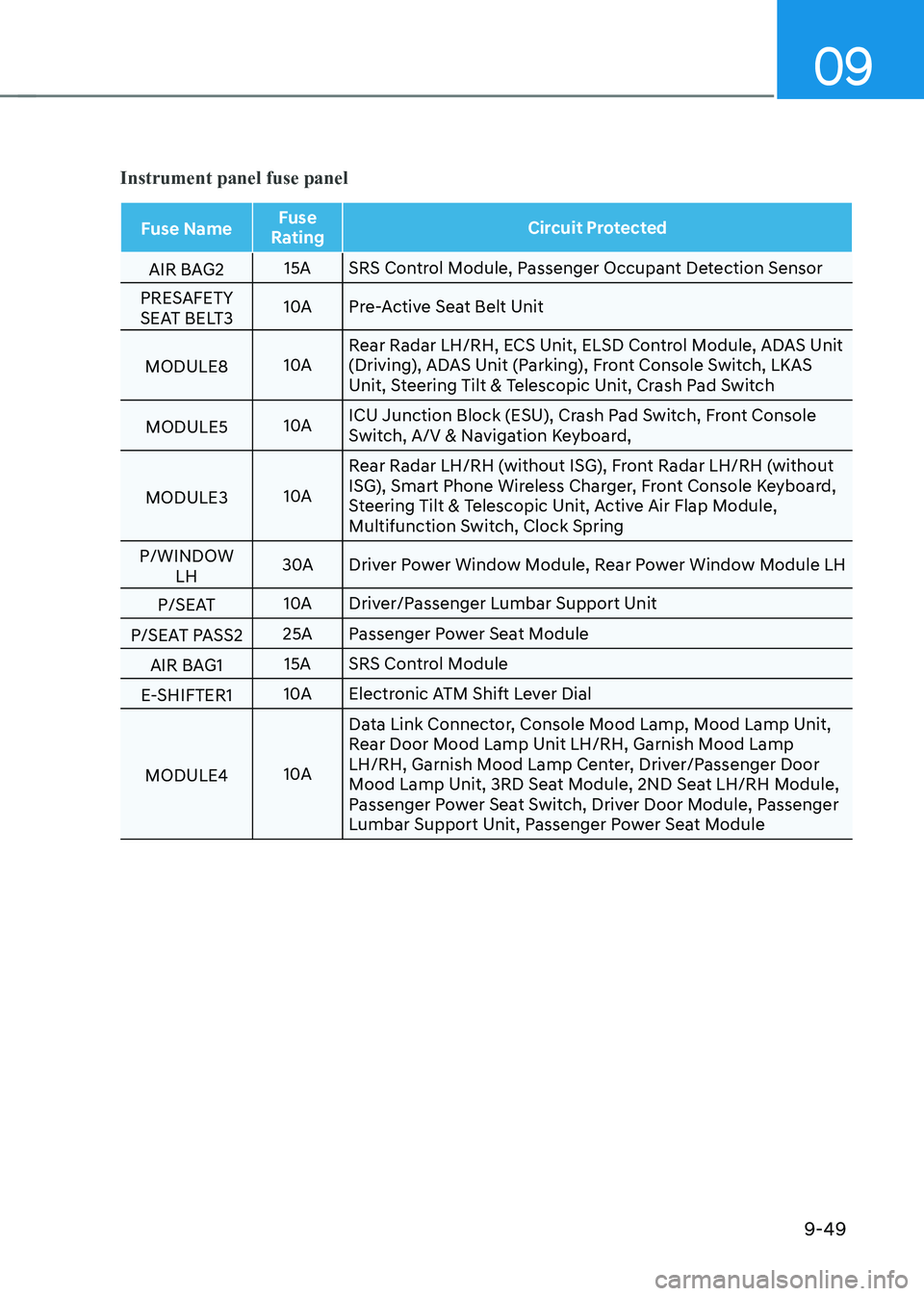
09
9-49
Instrument panel fuse panel
Fuse NameFuse
Rating Circuit Protected
AIR BAG2 15A
SRS Control Module, Passenger Occupant Detection Sensor
PRESAFETY
SEAT BELT3 10A
Pre-Active Seat Belt Unit
MODULE8 10ARear Radar LH/RH, ECS Unit, ELSD Control Module, ADAS Unit
(Driving), ADAS Unit (Parking), Front Console Switch, LKAS
Unit, Steering Tilt & Telescopic Unit, Crash Pad Switch
MODULE5 10AICU Junction Block (ESU), Crash Pad Switch, Front Console
Switch, A/V & Navigation Keyboard,
MODULE3 10ARear Radar LH/RH (without ISG), Front Radar LH/RH (without
ISG), Smart Phone Wireless Charger, Front Console Keyboard,
Steering Tilt & Telescopic Unit, Active Air Flap Module,
Multifunction Switch, Clock Spring
P/WINDOW LH 30A
Driver Power Window Module, Rear Power Window Module LH
P/SEAT 10A
Driver/Passenger Lumbar Support Unit
P/SEAT PASS2 25A
Passenger Power Seat Module
AIR BAG1 15A
SRS Control Module
E-SHIFTER1 10A
Electronic ATM Shift Lever Dial
MODULE4 10AData Link Connector, Console Mood Lamp, Mood Lamp Unit,
Rear Door Mood Lamp Unit LH/RH, Garnish Mood Lamp
LH/RH, Garnish Mood Lamp Center, Driver/Passenger Door
Mood Lamp Unit, 3RD Seat Module, 2ND Seat LH/RH Module,
Passenger Power Seat Switch, Driver Door Module, Passenger
Lumbar Support Unit, Passenger Power Seat Module